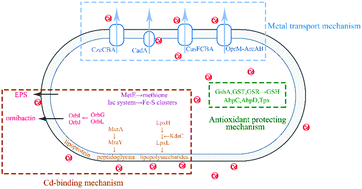Physiological, biochemical and proteomic insight into integrated strategies of an endophytic bacterium Burkholderia cenocepacia strain YG-3 response to cadmium stress
Abstract
An endophytic bacterium YG-3 with high cadmium (Cd) resistance was isolated from poplar grown in a composite mine tailing. It was identified as Burkholderia cenocepacia based on genomic, physiological and biochemical analyses. The Cd removal rate by YG-3 could reach about 60.0% in Cd aqueous solution with high concentrations of both 100 and 500 mg L−1. Meanwhile, various absorption and adsorption strategies were found in the two different Cd concentrations. The global resistance mechanisms of YG-3 were investigated in several levels, i.e., physiological observation, such as scanning electron microscopy and transmission electron microscopy; biochemical detection for active compound production and infrared spectroscopy; label-free quantitative proteomic profile analysis. The results indicated that YG-3 possesses a complex mechanism to adapt to Cd stress: (1) binding of Cd to prevent it from entering the cell by the cell wall components, as well as secreted siderophores and exopolysaccharides; (2) intracellular sequestration of Cd by metalloproteins; (3) excretion of Cd from the cell by efflux pumps; (4) alleviation of Cd toxicity by antioxidants. Our results demonstrate that endophyte YG-3 is well adjusted to largely remove Cd and has potential to cooperate with its host to improve phytoremediation efficiency in heavy metal-contaminated sites.



 Please wait while we load your content...
Please wait while we load your content...